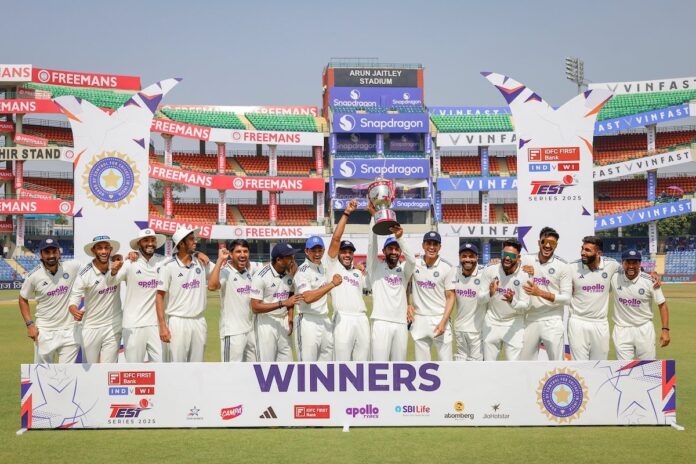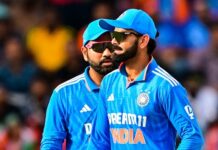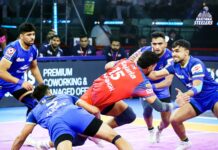
India thrashed the West Indies by seven wickets in the second and final Test in New Delhi on Tuesday, completing the formalities in just under an hour. This resulted in a 2-0 series sweep, with the much better hosts only being put to the test in the closing stages.
The victory will be remembered as Shubman Gill’s maiden series win as India’s Test captain in addition to reiterating India’s dominance at home.
India needed just 58 runs to reach the mark of 121, and they did so in 35.2 overs with KL Rahul (58 not out off 108 balls) and Dhruv Jurel (6 not out) at the crease. Rahul added 79 runs with Sai Sudharsan (39) for the second wicket, hitting six fours and two sixes.
The Feroz Shah Kotla surface did little to help spinners, being low and slow all through the second Test, which lingered into the fifth morning due in large part to the tenacity of centurions John Campbell (115) and Shai Hope (103), as well as a stubborn 10th-wicket partnership.
With pacers playing well on unfavorable grounds and spinners displaying patience as conditions at the Kotla became benign, Indian bowlers took all 40 opposition wickets in two Test matches.
In two matches, the top six Indian batsmen scored five hundreds and nearly 90.
However, when put in perspective, the benefits seem modest beyond the significant World Test Championship points, considering that none of the West Indies top-order batsmen now average 35 in Test cricket, let alone 40, which is the standard.
Furthermore, the majority of West Indian bowlers lacked significant first-class experience, with the exception of Jayden Seales. Jomel Warrican added one wicket to the three that Seales had taken in the first innings, meaning that Seales ended the game without taking any wickets.
After Kraigg Brathwaite, Roston Chase became the second West Indies captain to lose all five of his first Test matches as captain, despite his team’s late spark.
The real test for India will be against South Africa, and based on the first two days of the Pakistan-South Africa Test in Lahore, the Gaddafi Stadium’s turn and varying bounce is having a significant impact.
Spinners have captured 15 of the 16 wickets that have fallen throughout those two days. That begs the important question of whether it would be wise to play on flat batting tracks against a far more formidable South African lineup.
A batting order that includes Wiaan Mulder, Aiden Markram, Ryan Rickelton, Dewald Brevis, Tristan Stubbs, and Tony de Zorzi is a step up from this West Indies team.
https://x.com/BCCI/status/1977972672853110858
It could become more difficult against the Proteas if Indian spinners had trouble dismissing a subpar Caribbean team on a calm pitch.
Head coach Gautam Gambhir is still deeply hurt by the home series defeat to New Zealand last year. So, preparing rank turners remains a double-edged sword.
With the exception of Ravindra Jadeja and KL Rahul, this Indian batting lineup is relatively young. Nonetheless, Shubman Gill and Yashasvi Jaiswal have gained sufficient experience to manage difficult surfaces.
It is important to keep in mind that during the time when India frequently played on rank turners, the now-retired Virat Kohli’s Test average dipped. However, Ravindra Jadeja and Ravichandran Ashwin became world-beaters thanks to those same pitches.
Washington Sundar and Jadeja, both finger spinners, don’t seem nearly as dangerous on less useful surfaces. As a wrist spinner, Kuldeep Yadav is still a more effective choice in these conditions.
Given that there won’t be any red-ball cricket for the next eight months prior to the away series in Sri Lanka, the venues for the forthcoming two-Test series against South Africa will be essential in determining where India stands as a Test team at home.
The surface has rarely been a rank-turner at Eden Gardens. It has historically been an excellent batting pitch where bowlers must put in a lot of effort to succeed, but it also helps seamers in the early and late hours of play.
There is still uncertainty around the pitch’s behavior and the dynamics of the contest at Barsapara Stadium in Guwahati, which will host the first-ever Test match.









